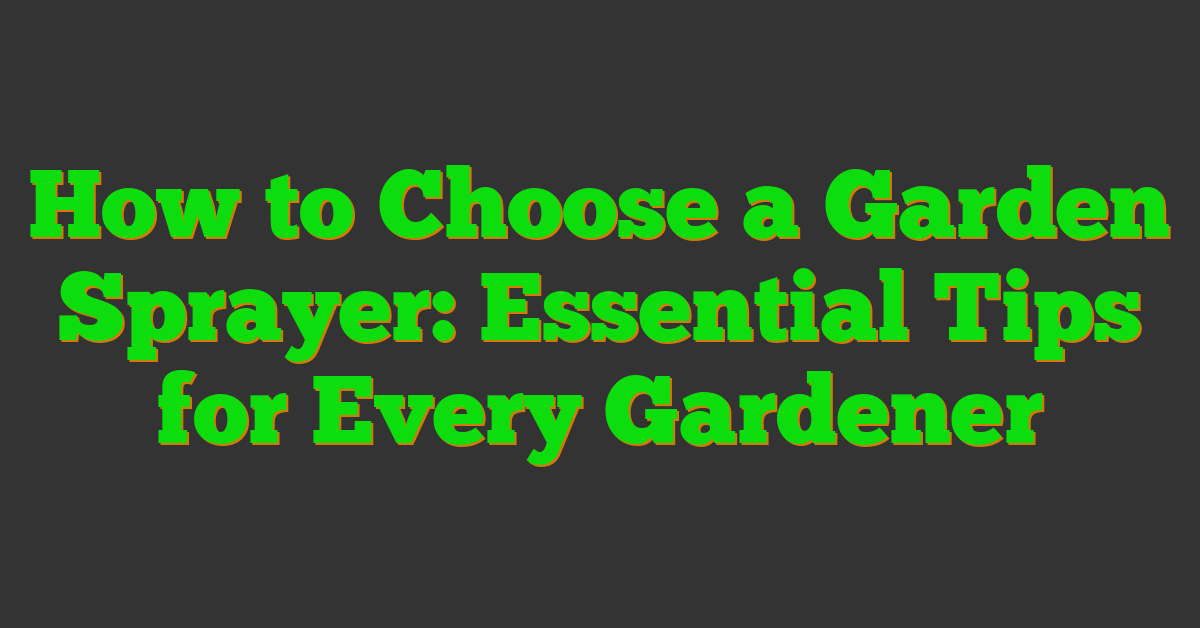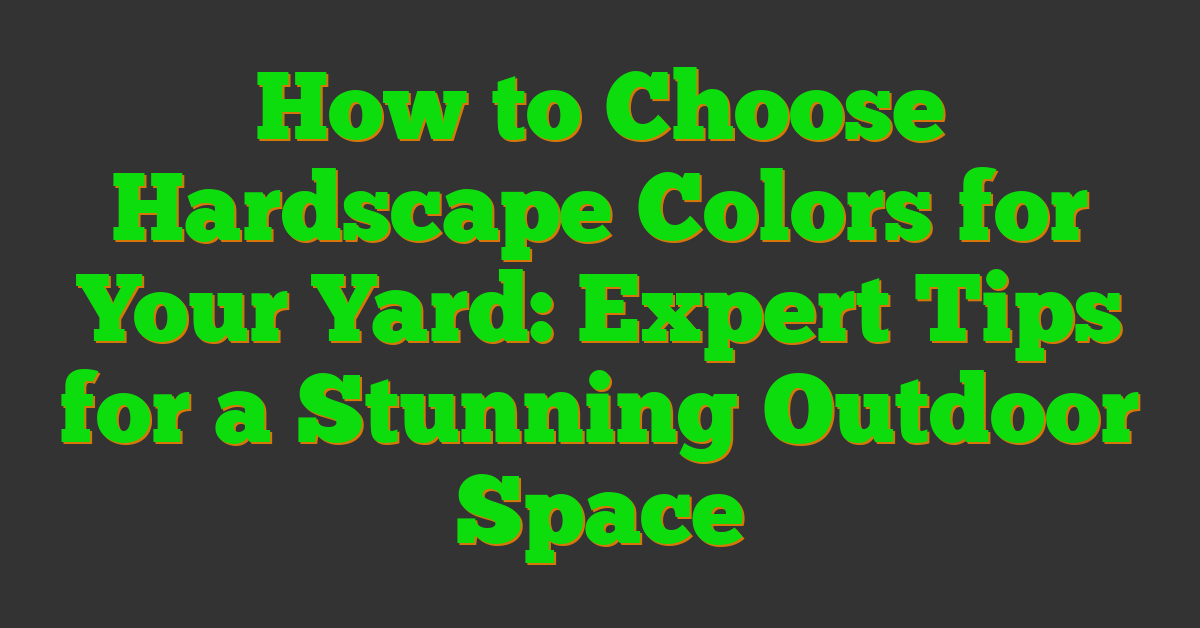Gardening is one of my favorite ways to unwind, and having the right tools makes all the difference. When it comes to keeping plants healthy and thriving, a good garden sprayer is essential.

But with so many options out there, choosing the right one can feel overwhelming. I’ve been there, trying to figure out which sprayer fits my needs best. In this guide, I’ll share tips and insights to help you find the perfect sprayer for your garden, ensuring your plants get the care they deserve.
Types of Garden Sprayers
Choosing the right garden sprayer depends on understanding the available types. Each sprayer offers unique features suited for different gardening tasks.
Manual Sprayers
Manual sprayers operate without electricity or batteries. They rely on hand pressure to disperse liquids. Typically lightweight, they are ideal for small gardens and spot treatments. Most models include adjustable nozzles for precise application, reducing chemical usage and ensuring targeted coverage.
Pump Sprayers
Pump sprayers use a built-in pump to generate pressure. They can handle larger volumes, making them suitable for medium to large gardens. Equipped with durable tanks, pump sprayers allow continuous spraying without frequent refills. Many models feature ergonomic designs and multiple spray patterns, enhancing user comfort and versatility.
Key Features to Consider
When choosing a garden sprayer, evaluating essential features ensures you select the best tool for your gardening tasks.
Spray Pattern and Coverage
Opt for a sprayer with adjustable spray patterns, including mist, fine spray, and jet. Adjustable patterns provide precise application, ensuring even coverage for various plant types and sizes. For instance, mist sprays work well for delicate flowers, while jet sprays handle larger foliage effectively.
Tank Capacity and Size
Assess tank capacity based on your garden size. Smaller tanks, around 1 to 2 liters, suit small gardens or spot treatments. Larger tanks, holding 5 liters or more, are ideal for extensive gardens, reducing the need for frequent refills and enhancing efficiency.
Materials and Durability
Selecting a sprayer made from quality materials ensures it withstands regular use and harsh conditions. Durable construction enhances the sprayer’s lifespan and performance.
Construction Quality
Top-tier garden sprayers use materials like stainless steel and high-impact plastics. Stainless steel parts resist bending and breaking, providing longevity. High-impact plastics reduce weight while maintaining strength, making the sprayer easier to handle. Secure seals and precise manufacturing prevent leaks and ensure consistent spray patterns, enhancing overall reliability.
Corrosion Resistance
Corrosion-resistant materials are crucial for sprayers exposed to water and chemicals. Stainless steel components resist rust and degradation, maintaining integrity over time. Tanks made from polypropylene or treated metals prevent chemical corrosion, ensuring safe storage of fertilizers and pesticides. Additionally, rubber or silicone gaskets offer extra protection against corrosive elements, extending the sprayer’s usable life.
Ease of Use and Maintenance
Choosing a garden sprayer that’s easy to handle and maintain makes gardening tasks smoother. I prioritize features that enhance comfort and simplify upkeep.
Ergonomics and Portability
Comfort during use is crucial. I look for sprayers with adjustable straps or comfortable grips to reduce fatigue during extended use. Lightweight materials, such as high-impact plastics, ensure the sprayer is easy to carry around the garden. Additionally, a balanced design prevents strain on the arms and shoulders, making it easier to reach all areas without discomfort.
Cleaning and Storage
Maintaining a sprayer’s performance starts with easy cleaning. I select models with detachable nozzles and wide openings for effortless rinsing. Materials like stainless steel and polypropylene resist corrosion, simplifying the cleaning process. For storage, I prefer compact designs that fit neatly in garden sheds or closets. Features like removable tanks and collapsible parts also save space, ensuring the sprayer stays in good condition and ready for the next use.
Safety Considerations
Using a garden sprayer safely protects both you and your plants. Here are essential safety tips:
- Wear Protective Gear
I use gloves, goggles, and long sleeves to prevent skin and eye contact with chemicals.
- Read Labels Carefully
I follow instructions for mixing and application to avoid misuse.
- Store Chemicals Properly
I keep pesticides and fertilizers in labeled containers away from children and pets.
- Check for Leaks
I inspect the sprayer before use to ensure there are no leaks that could cause spills.
« How Climate Change Affects Landscaping: Adapting Garden Practices for Sustainability Growing Edible Flowers in Your Garden: Expert Tips for Vibrant Harvests »
- Avoid Drift
I spray on calm days to minimize drift and prevent chemicals from affecting non-target areas.
- Clean the Sprayer After Use
I clean the sprayer thoroughly to prevent residue buildup and corrosion, maintaining its integrity.
- Use in Well-Ventilated Areas
I ensure proper ventilation when spraying to reduce inhalation of fumes.
- Handle with Care
I transport the sprayer carefully to avoid drops or impacts that could damage the equipment.
- Dispose of Chemicals Responsibly
I follow local regulations for disposing of unused or expired chemicals safely.
- Keep a First Aid Kit Nearby
I have a first aid kit accessible in case of accidental exposure or spills.
Price and Value
Choosing the right garden sprayer involves finding a balance between cost and the features you need. Garden sprayers typically range from $20 to $150, each price point offering different levels of functionality and durability.
Manual sprayers are the most affordable, costing between $20 and $50. They are ideal for small gardens and occasional use, providing basic spray patterns and smaller tank capacities. Pump sprayers fall in the $50 to $100 range, offering larger tanks and adjustable nozzles, making them suitable for medium to large gardens with more frequent use. Premium sprayers, priced from $100 to $150, include advanced features such as corrosion-resistant materials, ergonomic designs, and extended warranties, ensuring long-term reliability and ease of use.
| Price Range | Type | Features |
|---|---|---|
| $20 – $50 | Manual Sprayers | Basic spray patterns, smaller tanks, lightweight |
| $50 – $100 | Pump Sprayers | Larger capacity, adjustable nozzles, durable materials |
| $100 – $150 | Premium Sprayers | Advanced features, high-quality materials, extended warranties |
Investing in a higher-priced sprayer can offer better durability and additional features, providing greater value over time. Assessing your garden size and how often you’ll use the sprayer helps determine the best option within your budget.
Conclusion
Choosing the right garden sprayer has made my gardening tasks so much easier and more enjoyable. It’s all about finding what fits your garden size and personal comfort. I love how the right sprayer can make a real difference in keeping my plants healthy and thriving.
Take your time to explore the options and consider what features matter most to you. Investing in a quality sprayer not only saves time but also ensures your garden gets the care it deserves. Happy gardening!
















